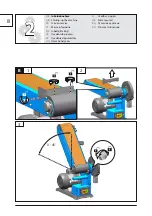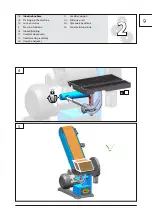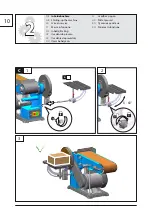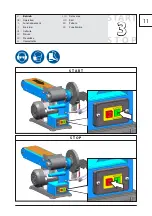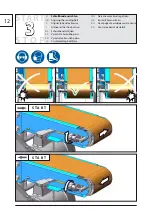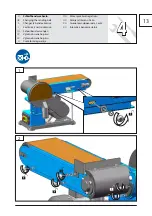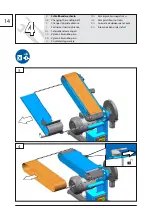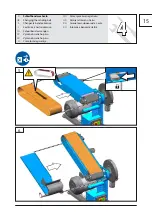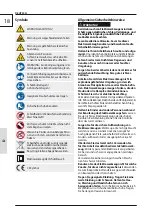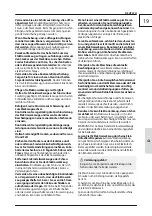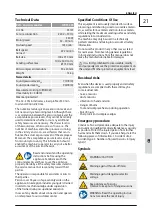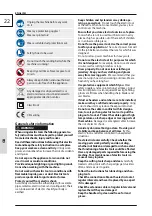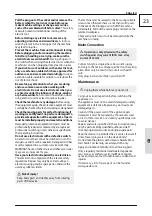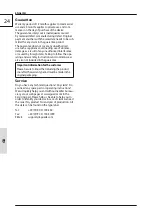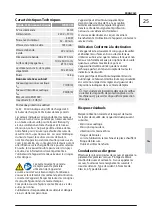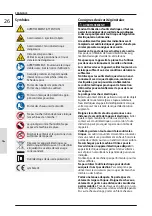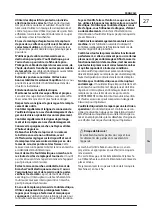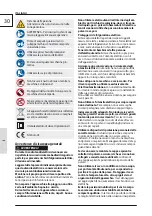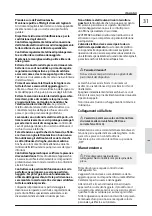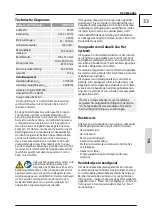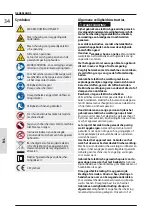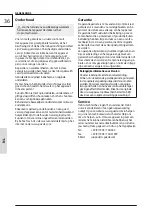
D
22
GB
ENGLISH
Unplug the machine before any work
on it.
Wear eye protective goggles !
Wear ear protectors!
Wear a suitable dust protection mask.
Safety shoes to be used
Do not touch the sanding belt while the
machine is running!
Keep dry at all times. Never expose tool
to rain.
Always keep children and unauthorised
persons out of reach of the appliance.
Any damaged or disposed electric or
electronic devices must be delivered to
appropriate collection centres.
Class II tool.
CE marking
General safety information
WARNING!
When using electric tools the following general sa-
fety instructions must be obeyed to protect yourself
from electric shocks, injury and fire risks.
Read all these instructions before using this electric
tool and keep the safety instruction in a safe place.
Keep your work area clean and tidy.
Untidy work-
places and workbenches increase the risk of accidents
and injuries.
Do not expose the appliance to rain and do not
use it in wet or moisture conditions.
Provide adequate lighting or good lighting condi-
tions when working with the machine.
Do not work with electric tools in conditions with
flammable liquids, gases or dust. Electric tools
produce sparks able to ignite dust or fumes.
Protect yourself from electric shock.
Avoid body contact with earthed objects (for example
pipes, radiators, electric stoves and cooling units). There
is an increased risk of electric shock if your body is
earthed.
Keep children and bystanders away while ope-
rating a power tool.
Do not touch the electric tool
or the cable. When not concentrated, you may lose
control over the machine.
Ensure that you store electric tools in a safe place.
Tools which are not in used must be stored in a dry
place as high as possible out of the reach of children
or in an inaccessible place.
Do not force the power tool. Use the correct power
tool for your application.
The correct power tool will
do the job better and safer at the rate for which it was
designed.
Do not use low-power machines for heavy work.
Do not use the electric tool for purposes for which
it is not designed.
For example, do not use a manual
circular saw for cutting branches or logs.
Dress properly. Do not wear loose clothing or
jewellery. Keep your hair, clothing and gloves
away from moving parts.
We recommend that you
wear non-slip shoes when working outdoors. Wear a
hairnet if you have long hair.
Use protective equipment which fit you.
Wear
safety goggles and ear protection at all times. A dust
mask or respirator is also required. Wear tight-fitting
gloves at all times when handling sharp blades and
saw blades,
If dust exhausters and catchers are to be installed,
make sure they are fitted and used properly.
Using
a dust exhauster may reduce the exposure to dust.
Do not use the cable in conflict with its designa-
tion, to carry or hang electric tools or to pull the
plug out of socket. Protect the cable against high
temperatures, oil, sharp edges or moving parts of
the machine.
Damaged or entangled cables increase
the risk of electric shock.
Avoid any abnormal body posture. Provide good
stability and keep balance at all times.
By this,
electric tools are better controlled in unexpected
situations.
Treat electric tools carefully. Check whether the
moving parts work perfectly and do not drag,
whether not broken or damaged to such an extent
that functioning of electric tools could be affected.
Have any damaged parts repaired before using the
machine. Poor maintenance of electric tools is a
cause of many injuries.
Keep the cutting tools sharp and clean.
Carefully
treated cutting tools with sharp edges get stuck less
often and are easier to guide.
Follow the instructions for lubricating and chan-
ging tools.
Check the connection cable on the electric tool at
regular intervals and have it replaced by an expert
if it is damaged.
Check the extension cables at regular intervals and
replace them if they are damaged.
Keep the handles dry, clean and free of oil and
grease.
Summary of Contents for GBTS 400
Page 69: ...65 ...

